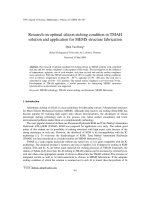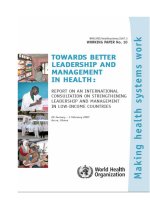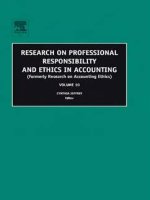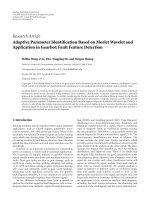RESEARCH ON PROFESSIONAL RESPONSIBILITY AND ETHICS IN ACCOUNTING VOLUME 10 pptx
Bạn đang xem bản rút gọn của tài liệu. Xem và tải ngay bản đầy đủ của tài liệu tại đây (1.16 MB, 238 trang )
RESEARCH ON PROFESSIONAL
RESPONSIBILITY AND ETHICS
IN ACCOUNTING
RESEARCH ON PROFESSIONAL
RESPONSIBILITY AND ETHICS
IN ACCOUNTING
(formerly Research on Accounting Ethics)
Series Editor: Cynthia Jeffrey
Volumes 1–5: Series Editor: Lawrence Poneman
Volumes 6–8: Series Editor: Bill N. Schwartz
Volume 9: Series Editor: Cynthia Jeffrey
RESEARCH ON PROFESSIONAL RESPONSIBILITY AND ETHICS IN
ACCOUNTING VOLUME 10
(formerly Research on Accounting Ethics)
RESEARCH ON
PROFESSIONAL
RESPONSIBILITY AND
ETHICS IN ACCOUNTING
EDITED BY
CYNTHIA JEFFREY
Iowa State University, Ames, USA
Amsterdam – Boston – Heidelberg – London – New York – Oxford
Paris – San Diego – San Francisco – Singapore – Sydney – Tokyo
2005
r 2005 Elsevier Ltd. All rights reserved.
This work is protected under copyright by Elsevier Ltd, and the following terms and conditions apply to its use:
Photocopying
Single photocopies of single chapters may be made for personal use as allowed by national copyright laws. Permission
of the Publisher and payment of a fee is required for all other photocopying, including multiple or systematic copying,
copying for advertising or promotional purposes, resale, and all forms of document delivery. Special rates are
available for educational institutions that wish to make photocopies for non-profit educational classroom use.
Permissions may be sought directly from Elsevier’s Rights Department in Oxford, UK: phone (+44) 1865 843830, fax
(+44) 1865 853333, e-mail: Requests may also be completed on-line via the Elsevier
homepage ( />In the USA, users may clear permissions and make payments through the Copyright Clearance Center, Inc., 222
Rosewood Drive, Danvers, MA 01923, USA; phone: (+1) (978) 7508400, fax: (+1) (978) 7504744, and in the UK
through the Copyright Licensing Agency Rapid Clearance Service (CLARCS), 90 Tottenham Court Road, London
W1P 0LP, UK; phone: (+44) 20 7631 5555; fax: (+44) 20 7631 5500. Other countries may have a local reprographic
rights agency for payments.
Derivative Works
Tables of contents may be reproduced for internal circulation, but permission of the Publisher is required for external
resale or distribution of such material. Permission of the Publisher is required for all other derivative works, including
compilations and translations.
Electronic Storage or Usage
Permission of the Publisher is required to store or use electronically any material contained in this work, including any
chapter or part of a chapter.
Except as outlined above, no part of this work may be reproduced, stored in a retrieval system or transmitted in any
form or by any means, electronic, mechanical, photocopying, recording or otherwise, without prior written permission
of the Publisher.
Address permissions requests to: Elsevier’s Rights Department, at the fax and e-mail addresses noted above.
Notice
No responsibility is assumed by the Publisher for any injury and/or damage to persons or property as a matter of
products liability, negligence or otherwise, or from any use or operation of any methods, products, instructions or
ideas contained in the material herein. Because of rapid advances in the medical sciences, in particular, independent
verification of diagnoses and drug dosages should be made.
First edition 2005
British Library Cataloguing in Publication Data
A catalogue record is available from the British Library.
ISBN: 0-7623-1239-4
ISSN: 1574-0765 (Series)
∞
The paper used in this publication meets the requirements of ANSI/NISO Z39.48-1992 (Permanence of Paper).
Printed in The Netherlands.
ELSEVIER B.V.
Radarweg 29
P.O. Box 211
1000 AE Amsterdam,
The Netherlands
ELSEVIER Ltd
84 Theobalds Road
London
WC1X 8RR
UK
ELSEVIER Ltd
The Boulevard, Langford
Lane, Kidlington
Oxford OX5 1GB
UK
ELSEVIER Inc.
525 B Street, Suite 1900
San Diego
CA 92101-4495
USA
Working together to grow
libraries in developing countries
www.elsevier.com | www.bookaid.org | www.sabre.org
CONTENTS
LIST OF CONTRIBUTORS vii
EDITORIAL INFORMATION ix
INVITED PAPER
FINANCIAL REPORTING QUALITY: A FOCUS ON
THE ROLE OF THE INDEPENDENT AUDITOR
Andrew D. Bailey, Jr. and Audrey A. Gramling 3
MAIN ARTICLES
ETHICAL TRAINING IN GRADUATE ACCOUNTING
COURSES: EFFECTS OF INTERVENTION AND
GENDER ON STUDENTS’ ETHICAL REASONING
Mohammad J. Abdolmohammadi 37
ACCOUNTING SCHOLARS PUBLISHING IN ETHICS
JOURNALS: A 30-YEAR LONGITUDINAL STUDY
Richard A. Bernardi 63
CPA
S IN PUBLIC PRACTICE: WHAT CODE DO THEY
USE WHEN FACED WITH AN ETHICAL DILEMMA?
Marshall K. Pitman and Robin R. Radtke 95
THE IMPACT OF THE SARBANES-OXLEY ACT ON
THREATS TO AUDITOR INDEPENDENCE
Michael K. Shaub 123
v
UNETHICAL DECISION-MAKING WITH COMPUTER
USAGE IN A UNIVERSITY ENVIRONMENT
Bernadette M. Ruf and Stuart B. Thomas 139
THE PLACE OF ETHICS SCHOLARSHIP IN THE U.S.
ACCOUNTING ACADEMY: ACCOUNTING
DOCTORATES’ RESEARCH PRODUCTIVITY IN
ETHICS JOURNALS
Richard A. Bernardi, David F. Bean and
Paul F. Williams
167
INSTRUCTIONAL CASES
AN INSTRUCTIONAL CASE IN USING RECEIVABLES
AS COLLATERAL FOR A LOAN: HARRISON
CHEMICAL CORPORATION
Steven M. Mintz and Mahmoud M. Nourayi 195
AN INSTRUCTIONAL CASE IN THE ETHICS OF THE
CPA/CLIENT RELATIONSHIP: THE ROADRUNNER
AND HOWARD BEAN, CPA
Lawrence Webb, Brendan O’Connell, Chris Carr and
Mark Higgins
211
CONTENTSvi
LIST OF CONTRIBUTORS
Mohammad J.
Abdolmohammadi
Bentley College, USA
Andrew D. Bailey Jr. Office of the Chief Accountant, United
States Securities and Exchange
Commission, USA
David F. Bean Hagan School of Business, Iona College,
USA
Richard A. Bernardi Gabelli School of Business, Roger Williams
University, USA
Chris Carr Orfalea College of Business, California
Polytechnic State University, USA
Audrey A. Gramling Office of the Chief Accountant, United
States Securities and Exchange
Commission and Kennesaw State
University, USA
Mark Higgins College of Business, University of Rhode
Island, USA
Steven M. Mintz Department of Economics, Claremont
McKenna College, USA
Mahmoud M. Nourayi Department of Accounting, Loyola
Marymount University, USA
Brendan O’Connell School of Business, James Cook University,
Australia
Marshall K. Pitman Department of Accounting, The University
of Texas at San Antonio, USA
Robin R. Radtke Department of Accounting, The University
of Texas at San Antonio, USA
Bernadette M. Ruf Department of Accounting and Finance,
Delaware State University, USA
vii
Michael K. Shaub School of Business and Administration, St.
Mary’s University, USA
Stuart B. Thomas Faculty of Management, University of
Lethbridge, Canada
Lawrence Webb Department of Accounting & Finance,
Monash University, Australia
Paul F. Williams College of Management, North Carolina
State University, USA
LIST OF CONTRIBUTORSviii
EDITORIAL INFORMATION
Managing Editor
Cynthia Jeffrey
Department of Accounting
College of Business
Iowa State University
Case Edi tor
Steven M. Mintz
Department of Economics
Claremont McKenna College
Editorial Review Board
Mohammed Abdolmohammadi
Bentley College
Elizabeth Dreike Almer
Portland State University
Vicky Arnold
University of Connecticut
Andrew Bailey
Securities and Exchange
Commission
C. Richard Baker
Adelphi University
Richard Bernardi
Roger Williams University
Susan Borkowski
La Salle University
Charlies Cullinan
Bryant College
Stan Davis
Indiana University – Purdue
University Ft. Wayne
Todd DeZoort
University of Alabama
Jesse Dillard
Portland State University
Mary Doucet
California State University
Bakersfield
ix
Dann Fisher
Kansas State University
Timothy J. Fogarty
Case Western Reserve University
Marty Freedman
Towson University
Karen Hooks
Florida Atlantic University
Steve Kaplan
Arizona State University
Julia Karcher
University of Louisville
Sara Kenny
College of St. Mary, Omaha
Jim Lampe
Texas Tech University
Morley Lemon
University of Waterloo
Steve Loeb
University of Maryland
Dawn W. Massey
Fairfield University
Mark Mitschow
SUNY College at Geneseo
Bruce Oliver
Rochester Institute of Technology
Carl J. Pacini
Florida Gulf Coast University
Michael A. Pearson
Kent State University
Kent St. Pierre
University of Delaware
Robin Radtke
University of Texas at San Antonio
Sara Reiter
SUNY-Binghampton
Robin Roberts
University of Central Florida
Pamela Roush
University of Central Florida
Bernadette Ruf
University of Akron
Donald Samelson
Colorado State University
Mike Schadewald
University of Wisconsin –
Milwaukee
Joe Schultz
Arizona State University
John Sennetti
Nova Southeastern University
Michael Shaub
St. Mary University
L. Murphy Smith
Texas A&M University
EDITORIAL INFORMATIONx
Charles Stanley
Baylor University
John Sweeney
Washington State University
Bill Thom as
Baylor University
Linda Thorne
York University
John Thornton
Washington State University
Carol Venable
San Diego State University
Paul Williams
North Carolina State University
George Young
Florida Atlantic University
The editors wish to thank the Editorial Board for the reviews they provided
this year. In addition to the review board, the editors wish to thank the
following ad hoc reviewers:
Kelly Richmond
Arline Savage
Timothy J. Louwers
Editorial Information xi
INVITED PAPER
FINANCIAL REPORTING QUALITY:
A FOCUS ON THE ROLE OF THE
INDEPENDENT AUDITOR
$
Andrew D. Bailey, Jr. and Audrey A. Gramling
‘‘y the [Securities and Exchange Commission] SEC requires public companies to dis-
close to the public meaningful financial and other information so that investors may
judge for themselves if a company’s securities are a sound investment. Only through the
steady flow of accurate, comprehensive, and timely information can the public make
informed investment decisions’’ (SEC, 2004, p. 6).
A current, and ongoing, priority of the SEC is to ensure that ‘‘investors have
accurate, adequate, and timely public access to disclosure materials that are
useful, and can be easily understood and analyzed across companies, in-
dustries, or funds’’ (SEC, 2004, p. 44). Financial reporting by SEC regis-
trants and their independent auditors serves the public interest and helps
protect investors by providing them with relevant, reliable, and understand-
able (i.e., quality) financial informatio n (Bailey, 2004).
1
We define financial reporting broadly to cover not only the primary fi-
nancial statements, but also ac companying schedules and disclosures. Con-
sistent with the FASB’s (1978) view, financial reporting includes
$
DISCLAIMER: As a matter of policy, the Securities and Exchange Commission disclaims
responsibility for any private publication or statement of any SEC employee or Commissioner.
This publication expresses the authors’ views and does not necessarily reflect those of the
Commission, the Commissioners, or other members of the staff.
Research on Professional Responsibility and Ethics in Accounting
Research on Professional Responsibility and Ethics in Accounting, Volume 10, 3–34
Copyright r 2005 by Elsevier Ltd.
All rights of reproduction in any form reserved
ISSN: 1574-0765/doi:10.1016/S1574-0765(05)10001-6
3
explanations and interpretations to help users better understand reported
financial information. For example, the usefulness of financial information
as an aid to investors can be enhanced by management’s explanations of
that information. Such explanations might include complete and accurate
presentations by management in the Management Discussion & Analysis
(MD&A) section of the annual report, footnot es to the financial statements
that are in plain English, and detailed descriptions of identified material
weaknesses in internal control.
The independent auditor is an important determinant of financial re-
porting quality. Notwithstanding this significant role, the independent au-
ditor is only the last key gatekeeper before dissemination of financial reports
to the marketplace. Many other parties play important roles in helping
ensure the quality of financial reporting to current and potential investors.
As suggested in Exhibit 1, we contend that financial reporting quality is a
direct function of the quality of: (1) the reports prepared by management;
Exhibit 1. Determinants of Financial Reporting Quality: A Focus on
the Independent Audit.
Quality of
Management
Prepared Reports
Financial Reporting
Quality
Standard
Setters
Regulators
Public Company
Quality of
Internal Audit
Activities
Quality of
Oversight by the
Audit Committee
Quality of the
Independent Audit
Other
External
Monitoring
Mechanisms
Independent Audit Firm
Quality
Control
Culture
Monitoring
Personnel
Tools
ANDREW D. BAILEY AND AUDREY A. GRAMLING4
(2) internal audit activity; (3) oversight by the audit committee; and (4) the
audit performed by the independent auditor.
Other parties and institutions, although not directly involved in the prep-
aration, oversight, and audit of financial information associated with a par-
ticular entity, play critically important roles in determining financial reporting
quality. These parties establish the environment in which financial reports are
provided to investors, and the rules that must be adhered to in preparing and
auditing such reports. These parties and institutions include standard setters
(e.g., FASB, PCAOB, SEC), regulators, and other institutions that provide
various inspection, discipline, and enforcement mechanisms (e.g., SEC,
PCAOB, legal environment, listing exchanges, state boards of accountancy)
and other external monitors (e.g., analysts, institutional investors).
The purpose of this paper is to review the roles of these parties that have
responsibilities that affect financial reporting qua lity. While we acknowledge
and discuss the roles of many parties, our primary focus is on the role of the
independent auditor, whom we believe must commit to the independent
audit with the mindset of serving primarily the financial markets and the
public interest (see also Nicolaisen, 2004). We have two additional objec-
tives. First, we challenge the auditing profession to address the many factors
that can positively contribute to or that currently detract from their ability
to enhance financial reporting quality. Second, we identify possible aca-
demic research opportunities that can contribute to our understanding of
the necessa ry and sufficient determinants of financial reporting quality.
WHAT IS FINANCIAL REPORTING QUALITY?
Before discussing the roles of the parties responsible for financial reporting
quality, it will be helpful to briefly discuss what is meant by the term fi-
nancial reporting quality. The characteristics of financial reporting quality
are outlined in the professional accounting literature. Because these char-
acteristics are difficult to measure directly, the academic literature has used a
variety of proxies (i.e., measures) to capture these characteristics.
Characteristics of Financial Reporting Quality in the Professional
Accounting Literature
A goal of financial reporting is to provide information to investors that is
useful for investment decision-making purposes (FASB, 1978).
2
Accordingly,
Financial Reporting Quality: A Focus on the Role of the Independent Auditor 5
financial reporting quality can be assessed in terms of whether the informa-
tion is deemed useful for investor decision making. According to the FASB:
The qualities that distinguish ‘‘better’’ (more useful) information from ‘‘inferior’’ (less
useful) information are primarily the qualities of relevance and reliability, with some
other characteristics that those qualities imply (FASB, 1980, p. 15).
A r eview of th e professional accounting literature (see, in particular, FASB,
1980 for a more detailed discussion) suggests that the characteristics related to
relevance include predictive value (e.g., earnings persistence, disaggregated in-
formation), feedback value, and timeliness. Characteristics related to reliability
include ve r ifiability, completeness, substance/representational faithfulness , and
neutrality. Comparability, including consistency, is viewed as interacting with
both relevance and reliability to contribute to the goal of decision usefulness.
These characteristics are difficult for the financial statement users to ob-
serve directly, are typically difficult to measure on an ex ante basis, and
hence are often assessed on an ex post basis. The academic literature has
used a somewhat imperfect set of proxies to capture various characteristics
of financial reporting quality.
Measures of Financial Reporting Quality in the
Academic Accounting Literature
3
The academic literature has used various approaches to measuring financial
reporting quality, many of which focus on output or perception measures.
4
Some measures tie directly to the characteristics identified by the FASB
(1980). For example, Subramanyam (1996) and Barth, Cram, and Nelson
(2001) attempt to capture an aspect of relevance by using predictability of
future cash flows as a measure of usefulness or quality.
Others have used measures related to reliability, including the accuracy of
the financial information, as measures of qua lity. Such measures have in-
cluded whether a restatement was necessary (e.g., Myers, Myers, Palmrose,
& Scholz, 2004), there was compliance of a firm’s financial reports with
applicable reporting standards (e.g., Gaeremynck, Van der Meulen, &
Willekens, 2003), or the financial statements contained a fraudulent mis-
statement, possibly causing the registrant to face an SEC enforcement action
related to inaccurate financial reporting (e.g., Beasley, 1996).
Some researchers have addressed the issue of reliability through measures
described as credibility measures. For example, Farber (2005) uses measures
of analyst following and institutional holdings as indicative of perceived
financial reporting credibility. Mercer (2005) assesses credibility by examining
ANDREW D. BAILEY AND AUDREY A. GRAMLING6
investors’ beliefs about management’s competence and trustworthiness related
to their financial disclosures. Khurana and Raman (2004) suggest that the ex
ante cost of equity capital is an estimable proxy for financial reporting cred-
ibility. Finally, the earnings response coefficient (ERC), a measure of the
extent to which the market responds to earnings (i.e., earnings quality), has
been used as a measure of financial reporting quality (e.g., Balsam, Krishnan,
& Yang, 2003), and might be viewed as a quality perception measure.
Still, other researchers have used proxies that may be less intuitive as
measures of financial reporting quality. For example, Myers, Myers, and
Omer (2003) use measur es of accruals, including the dispersion and sign of
both absolute Jones-model abnormal accruals and absolute current accruals
(also see Krishnan, 2003). Accrual measures are thought to be indicative of
earnings management, and earnings management is generally believed to
lead to lower financial reporting quality (Dechow & Schrand, 2004, p. 58).
Other proxies for financial reporting quality attempt to capture some aspect
of earnings management, or at least are perceived to be red flag indicators of
earnings management. For example, registrants that issue financial reports
with earnings that consistently just meet or beat targets or forecasts may
have had to manage earnings to do so (Dechow & Schrand, 2004, p. 75; e.g.,
Kasznik, 1999), and thus may represent lower quality financial reporting.
Finally, measures based on assessments made by rating agencies, analysts,
or other professional groups have also proxied for aspects of financial re-
porting quality. For example, Dunn and Mayhew (2004) use the Association
for Investment Management and Research (AIMR) analysts’ ratings of
disclosure quality as a quality measure (see also Lang & Lundholm, 1993).
DETERMINANTS OF FINANCIAL REPORTING
QUALITY
In this section, we recognize the many determinants of financial reporting
quality. As suggested in Exhibit 1, the actions of management, the audit
committee, the internal auditors, and the independent auditor directly affect
financial reporting quality, and in turn the activities of these four parties are
influenced by the nature of the financial reporting environment.
Parties Influencing the Financial Reporting Environment
The primary parties who influence the financial reporting environment include
standard setters (e.g., FASB, PCAOB, SEC), regulators and other institutions
Financial Reporting Quality: A Focus on the Role of the Independent Auditor 7
that provide various inspection, discipline, and enforcement mechanisms (e.g.,
SEC, PCAOB, legal environment, listing exchanges, state boards of account-
ancy) and other external monitors (e.g., analysts, institutional investors).
Standard setters (e.g., FASB, PCAOB, SEC) provide the frameworks
within which financial statements are prepared and audited. Standards
should be effective in helping achieve financial reporting quality, while
considering both costs and benefits. Standards should result in consistent
application by preparers and auditors, without undue complexity.
Accounting standards set the ‘‘floor’’ for accounting and disclosures by
management to the users of financial information. (See Hackenbrack and
Nelson (1996) and Trompeter (1994) for research evidence on accounting
standards as a determinant of financial reporting quality.) In preparing its
financial information, the public company, through its management, audit
committee, and internal audit function, must be committed to not merely
the letter of the accounting standards, but to their intent. Accounting
standards, however, might limit the independent auditor’s contribution to
financial reporting quality. For exampl e, the precision of the audited num-
bers may be bounded by the precision of the underlying accounting numbers
based on the standards. (However, see Power (1996) for an alternative view
that auditors can create aud itable numbers without regard to the precision
implicit in the accounting standards themselves.)
Auditing standards, when properly applied by independent auditors, are
intended to reduce the incidence of materially misstated financial statements
originating from the public company. Auditing standards set the ‘‘floor’’ for
audit processes and procedures. However, we recognize that the auditor’s
ability to effectively apply the standards, and contribute to financial report-
ing quality is influenced by the preparers’ actions. For example, in situations
where preparers present accurate, yet somewhat incomplete, disclosures, the
auditor may face difficulties in requiring the registrant to present a more
complete, and hence more useful or higher quality, disclosure.
Regulators act to discourage various behaviors and to provide certain
disincentives in an effort to achieve desired actions. Standard setters, in
conjunction with regulators, establish principles and objectives, provide
guidance where necessary, prohibit certain behaviors, and provide penalties
when behavior deviates from the established expectations. A balanced com-
bination of disincentives, guidance, and prohibitions from regulators and
standard setters is necessary in affecting financial reporting quality.
Institutional investors and analysts have the potential to serve monitoring
roles with respect to financial reporting quality. The presence of institutional
investors is thought to decrease a firm’s incentives for low-quality finan cial
ANDREW D. BAILEY AND AUDREY A. GRAMLING8
reporting (e.g., earnings management or intentional misreporting via a
variety of mechanisms (Dechow & Schrand, 2004)). While the academic
literature provides some evidence that institutional investors serve as effec-
tive monitors of financial reporting quality (e.g., Bushee, 1998), literature on
the effectiveness of analysts as monitors is somewhat more limited (e.g.,
Hirst & Hopkins, 1998).
Other mechanisms, such as our legal environment, enforcement actions by
the SEC, enforcement and inspection activities of the PCAOB, oversight
activities by state boards of accountancy, and requirements mandated by
listing exchanges, provide disciplinary threats for those having a direct role
in the preparation, review, and audit of financial information. While these
types of mechanisms are often viewed with some discomfort by parties in-
volved in the preparation, oversight, an d audit of financial information, it
seems clear that penalties and the threat of penalties can influence the be-
haviors of these parties. (See Gramling, Schatzberg, Bailey, & Zhang (1998)
for an example of research showing a relationship between the legal liability
environment and auditor behaviors.)
Parties with a Direct Role in the Preparation, Oversight, and Audit of
Financial Information
Management is responsible for preparing financial statements for dissem-
ination to the public. Further, in an effort to enhance financial reporting
quality, various sections of the Sarbanes-Oxley Act of 2002 (hereafter SOX)
require management to certify the effectiveness of disclosure controls and
procedures, as well as internal control over financial reporting. However,
management’s role in determining financial reporting quality extends be-
yond the preparation of financial information and assertion of internal
control effectiveness. It is important, for example, to also recognize the
strong influence of management in setting the overall tone for the organ-
ization, including the importance placed on financial reporting quality
(Cohen, Krishnamoorthy, & Wright, 2002).
The internal audit function contributes to financial reporting quality
through its ongoing audit activities and its relationships with management,
the audit committee, and the independent auditor. (See Gramling, Maletta,
Schneider, & Church (2004) for discussion on the internal audit function’s
relationships with these parties.) The internal audit function has played
some role in financial reporting as early as the 1940s (Moeller, 2004), and
that role has evolved over time. The nature of internal audit activity today
typically includes financial and fraud audits, risk and control self-assessment
Financial Reporting Quality: A Focus on the Role of the Independent Auditor 9
initiatives, control assurance, and compliance work, most of which influence
financial reporting quality.
The annual audit completed by the independent auditor is an important
determinant of financial reporting quality, and the internal audit function
can serve as a resource to the independent auditors in completing the annual
audit (SAS No. 65 AICPA, 1991; AS 2, PCAOB, 2004a). The work of a
competent and independent internal audit function will affect the nature,
timing, and extent of the annual independent audit work, including proce-
dures the independent auditor performs when obtaining an understanding of
the entity’s internal control, when assessing risk, when gathering substantive
evidence, and in performing an internal control assessment. In performing
the audit, the independent auditor may, as permitted by auditing standards,
rely on work already performed by internal auditors and/or request direct
assistance from them (i.e., a specific request for the internal audit function to
complete some aspect of the independent auditor’s work).
The importance of the internal audit function as a determinant of finan-
cial reporting quality is highlighted by recently enacted listing rules for the
NYSE, as approved by the SEC, requiring that an entity maintain an in-
ternal audit function that would likely interact with both the audit com-
mittee and management. This interaction would typically involve the
internal audit function providing the audit committee and management with
ongoing assessments of the company’s risk management processes and sys-
tem of internal control (SEC, 2003).
Historically, the audit committee has had oversight responsibility of man-
agement’s financial reporting. That role has expanded today to typically
include engaging and monitoring the external auditor (SOX), overseeing
both internal and independent auditor activities (DeZoort, Hermanson,
Archambeault, & Reed, 2002), and monitoring the independence of the in-
dependent auditor (SOX). SOX has imposed additional requirements on the
audit committee that are intended to enhance financial reporting quality. For
example, Section 301 of SOX requires the audit committee to establish a
whistleblower program to allow for reporting of potential financial account-
ing problems, and mandates that the audit committee members be inde-
pendent. Section 407 notes that audit committees should be comprised of at
least one member who is a financial expert, thereby increasing the quality
(i.e., competence) of the audit committee in its oversight responsibility.
Efforts such as Sections 301 and 407 to improve the quality of the audit
committee appear warranted given the various academic studies that suggest
that financial reporting quality is associated with audit committee quality
(e.g., Beasley, 1996; Beasley, Carcello, & Hermanson, 1999; Beasley,
ANDREW D. BAILEY AND AUDREY A. GRAMLING10
Carcello, Hermanson, & Lapides, 2000; DeZoort, 1998; McMullen &
Raghunandun, 1996).
5
The primary role of the independent auditor is to provide an independent
audit of the financial reports prepared by management. Through this role,
the independent auditor adds credibility to management’s financial reports
(Power, 1996). The need for enhanced credibility of management prepared
financial reports is best understood within a framework which recognizes
the presence of information asymmetries.
Information asymmetry between management and owners (as well as
other contracting parties) creates a demand for a measure of firm perform-
ance (Dechow, 1994). Periodic financial reports are one of the primary
mechanisms for communicating information about registrant performance
to owners and other individuals outside of the organization (FASB, 1978).
The level of reliability of financial reports prepared by management is an
important determinant of the usefulness of those reports (FASB, 1980; Wild,
1996). However, it is difficult for outside parties to assess the reliability of
the financial information prepared by management (Dechow, 1994).
Given the existence of information asymmetries, and the potential for
conflicts of interest between company management and the outside users of
financial information, an audit by an independent third party can serve as a
mechanism to enhance the reliability of the financial information reported
by management (e.g., Kinney & Martin, 1994; Watts & Zimmerman, 1986).
Several researchers have suggested the mechanisms through which the
audit improves the quality of management prepared financial reports. For
example, auditors are thought to improve the quality of financial reports
through their ability an d willingness to be discriminating in examining
management’s records and in resisting client pressures (see DeAngelo, 1981).
Similarly, Francis, Maydew, and Sparks (1999) pro pose that an audit im-
proves the quality of financial reports by constraining aggressive and ques-
tionable accounting practices of management.
A FOCUS ON AUDIT QUALITY AS A DETERMINANT
OF FINANCIAL REPORTING QUALITY
While the above discussion suggests there are numerous determinants of
financial report ing quality, many investors in the marketplace have an ex-
pectation that audit quality is the key determinant of financial reporting
quality. However, assessments of audit quality are somewhat problematic
for investors. The assessment often occurs on an ex post basis, for example
Financial Reporting Quality: A Focus on the Role of the Independent Auditor 11
when there appears to be evidence of low-quality financial reporting, as in
the case of a financial statement restatement or litigation or an SEC en-
forcement action.
A complication when discussing audit quality in such instances is that
social norms and points of views greatly influence what is expected from an
audit in terms of the assurance level provided (Smieliauskas & Lam, 2004).
We recognize that some investors might perceive that an audit is intended to
provide absolute assurance that there are no material misstatements in the
financial statements (Epstein & Geiger, 1994), without regard to the actions
of the other parties responsible for financial reporting quality. From this
perspective, an instance of low-quality financial reporting (e.g., a misstate-
ment) would indicate low-quality auditing. Alternatively, auditors and other
investors might view an audit as providing reasonable, but not absolute,
assurance regarding the accuracy of management’s financial statements.
Those with this perspective might not categorize all instances of low-quality
financial reporting as eviden ce of low-quality auditing. Alternatively, audit
quality might be assessed on the basis of the process adhered to in com-
pleting the audit engagement (i.e., through various input measures). For
example, assessments of audit quality might be based on the execution of
audit procedures, documentation of audit findings, and compliance with
policies and standards.
In the following section s we discuss various potential measures of audit
quality, and, in some instances, provide examples of academi c literature
utilizing these measures. Currently, audit quality is measured in both the
practice and academic literatures throu gh limited approaches. These ap-
proaches attempt to capture the inputs and outputs of the audit process and
typically utilize various ex post measures based on publicly available infor-
mation. As with management’s greater knowledge about their financial re-
porting quality, the auditor has more insight than the investor about the
quality of the audit and the process adhered to in completing an audit
engagement. And, like management, the auditor has incentives to retain
engagement specific private information about audit quality.
Output Measures of Audit Quality
If audit quality is primarily defined on the basis of an output measure, that
output measure must, at least loosely, relate to an opinion that appropri-
ately assesses the accuracy of management’s assertions. That is, a possible
output measure of audit quality would be whether the opinion is reflective of
ANDREW D. BAILEY AND AUDREY A. GRAMLING12
the accuracy of management’s assertions. This approach is used in academic
literature by researchers that discuss audit quality in terms of whether, for
example, a going concern opinion was issued for a company subsequently
declaring bankruptcy (e.g., Mutchler, Hopwood & McKeown, 1997).
Some output measures that have been used to proxy audit quality are the
same measures researchers use to proxy financial reporting quality. How-
ever, these measures do not typically provide unambiguous evidence about
audit quality. For example, cases where a restatement occurs after an un-
qualified audit opinion has been issued have been cited as evidence of
low-quality auditing (e.g., Myers et al., 2004, p. 6). Non-compliance with
disclosure requirements has also been used as a measure of audit quality
(Krishnan & Schauer, 2000). Possibly, the assumption in using such meas-
ures to proxy for audit quality is that the independent auditor is the last key
gatekeeper before financial information is disseminated to the marketp lace,
and thus bears ultimate responsibility for the overall financial reporting
quality. We question whether such measures are truly measures of audit
quality, or whether they are more global measures of overall financial re-
porting quality, which is dependent on the quality of the many determinants
identified in Exhibit 1, including audit quality. Palmrose and Scholz (2004)
discussion recognize, for example, that restatements are reflective of both
financial reporting quality and audit quality.
Input Measures of Audit Quality
The output measures discussed above become more meaningful in a context
that recognizes the various inputs to audit quality. That is, what inputs were
employed and what processes were used to arrive at the issued audit opin-
ion? Many input measures are obtained on an ex post basis, for example,
through quality control reviews that include an assessment of audit work-
papers (e.g., Deis & Giroux, 1992), through subsequent litigation out-
comes (e.g., Palmrose, 1988), through the results of reviews (e.g., Colbert &
Murray, 1998) and, going forward, through the published results of the
PCAOB’s newly implemented inspection process.
A que s tion arises as to the ap propriate inputs to audit quality and how such
inputs are assured on an ongoing basis. As suggested in Exhibit 1, the inputs
to audit quality, which are an audit firm’s responsibility, result from a firm-
wide quality control system (Wooten, 2003) that ensures a proper organiza-
tional culture, emphasizes the importance of internal monitoring,employs
appropriate personnel, and provides proper tools for audit engagement
Financial Reporting Quality: A Focus on the Role of the Independent Auditor 13









